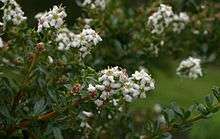Escallonia
Escallonia is a genus of shrubs and trees in the family Escalloniaceae. They are native to North and South America.[1]
| Escallonia | |
|---|---|
 | |
| Escallonia virgata | |
| Scientific classification | |
| Kingdom: | Plantae |
| Clade: | Tracheophytes |
| Clade: | Angiosperms |
| Clade: | Eudicots |
| Clade: | Asterids |
| Order: | Escalloniales |
| Family: | Escalloniaceae |
| Genus: | Escallonia Mutis ex L.f. |
| Species | |
|
See text | |
Taxonomy
Currently valid species in Escallonia are:[2]
- Escallonia alpina
- Escallonia angustifolia
- Escallonia bifida
- Escallonia callcottiae
- Escallonia chlorophylla
- Escallonia cordobensis
- Escallonia discolor
- Escallonia farinacea
- Escallonia florida
- Escallonia gayana
- Escallonia herrerae
- Escallonia hispida
- Escallonia hypoglauca
- Escallonia illinita
- Escallonia laevis
- Escallonia ledifolia
- Escallonia leucantha
- Escallonia megapotamica
- Escallonia micrantha
- Escallonia millegrana
- Escallonia myrtilloides
- Escallonia myrtoidea
- Escallonia obtusissima
- Escallonia paniculata
- Escallonia pendula
- Escallonia petrophila
- Escallonia piurensis
- Escallonia polifolia
- Escallonia pulverulenta
- Escallonia resinosa
- Escallonia reticulata
- Escallonia revoluta
- Escallonia rosea
- Escallonia rubra
- Escallonia salicifolia
- Escallonia schreiteri
- Escallonia serrata
- Escallonia tucumanensis
- Escallonia virgata
Cultivation
Widely cultivated and commonly used as hedging plants, especially in coastal areas, escallonias grow about 30 cm (12 in) per year, reaching 1.5–3 m (5–10 ft) in height, with arching branches of small, oval, glossy green leaves. Flowering from June to October (in the Northern Hemisphere), they have masses of small pink, white or crimson flowers, sometimes with a honey fragrance. They are best grown in full sun with some shelter. Some varieties are not fully hardy in all areas.[3] Numerous cultivars and hybrids have been developed, of which the following have gained the Royal Horticultural Society's Award of Garden Merit:[4]
Gallery
 Escallonia macrantha
Escallonia macrantha
_Pers._by_Pato_Novoa_-_004.jpg) Escallonia revoluta
Escallonia revoluta- An Escallonia cultivar as a roadside planting
References
- The Royal Horticultural Society Encyclopedia of Plants, Ed. Christopher Brickell, Dorling Kindersly, London, 1996. ISBN 0751304360. p.419
- "Escallonia — The Plant List". www.theplantlist.org. Retrieved 2017-08-19.
- RHS A-Z encyclopedia of garden plants. United Kingdom: Dorling Kindersley. 2008. p. 1136. ISBN 1405332964.
- "AGM Plants - Ornamental" (PDF). Royal Horticultural Society. July 2017. p. 37. Retrieved 19 February 2018.
- "RHS Plant Selector - Escallonia 'Apple Blossom'". Retrieved 19 June 2020.
- "RHS Plant Selector - Escallonia 'Donard Radiance'". Retrieved 19 June 2020.
- "RHS Plant Selector - Escallonia 'Iveyi'". Retrieved 19 June 2020.
- "Escallonia 'Langleyensis'". RHS. Retrieved 19 June 2020.
- "RHS Plant Selector - Escallonia 'Peach Blossom'". Retrieved 19 June 2020.
- "RHS Plant Selector - Escallonia 'Pride of Donard'". Retrieved 19 June 2020.
- "Escallonia bifida". RHS. Retrieved 19 June 2020.
- "Escallonia rubra 'Crimson Spire'". RHS. Retrieved 19 June 2020.
![]()